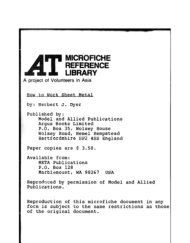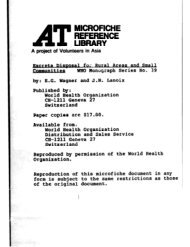Create successful ePaper yourself
Turn your PDF publications into a flip-book with our unique Google optimized e-Paper software.
a<br />
J c7 J-<br />
II 1<br />
-i, -.<br />
i-!b<br />
RESTORATIONS, ..SHAWLS I WI ~<br />
T 17th century Philipsburg, Upper<br />
A, Mills, in North .TarrS;town, Nef -’<br />
York and at Van Cortlandt Manor in<br />
. nearby C&on-on-Hudson, authenticity is<br />
.<br />
*<br />
the ‘name of the game. When Sleepy<br />
Hollow’ Restorations wanted a a dozen<br />
shawls t*o complem&t costumes worm by<br />
hostesses at these historic landmarks,<br />
handspun yarns had to be dyed with<br />
c natural dyes.<br />
Sample cards of colors possible in Colonial<br />
times were contributed by members<br />
“of the Handweavers Guild of WestchesJ<br />
: ter, whose interest’ in plant dyeing ‘had<br />
originally been stimulated by the Brooklyn<br />
Botanic Garden’s workshops. Matching<br />
the selected shades was the challenge,<br />
and the following procedures relate to<br />
this task. With few exceptions the recipes<br />
used are given ,in B.B.G. Handbook<br />
46.<br />
No.<br />
For mordanting and dyeing the 3<br />
pounds of woql needed for each shawl, an<br />
ll-gallon enamel clam-steamer pot was<br />
employed. The first sample attempted had<br />
been dyed with wilted lilacs. After mordanting<br />
with alum and cream of tartar,<br />
the yarn was simmered for abaut two<br />
.. hours with as many lilac.blossoms as the<br />
dyepot would accommodate. .<br />
P 77 * I<br />
An akenture<br />
!i.<br />
jn match’ing*colors<br />
., 1,<br />
I<br />
==L<br />
/_<br />
Sylvia Thorne ,<br />
To test for a match, the sample was<br />
wetted. Then a few. strands of the newly.<br />
dyed yarn were squeezed between paper<br />
towels and both examined together in<br />
good daylight. After all dyestuff had been<br />
abstracted the resulting yellow still lacked<br />
substance. The addition of a “very small<br />
duced an entirely different yellow. Flow-<br />
ers held in a,.freezer from’ thk previous<br />
!summer were boiled until the liquor be-<br />
/’ 1 a dark bronze and then strained out<br />
re the .wool was immersed.? When the<br />
developed the yarn<br />
to become ‘fig1 in the dye I<br />
duplicating a sample origi- ’<br />
saffron proved prohibisubstitute<br />
was found in ,the recipe<br />
of Brooklyn Handbook -. y<br />
with smartweed (Polyr D<br />
A bushel-, of ‘this<br />







